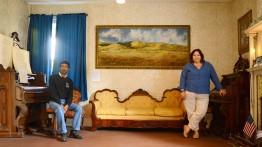Evan Curtis Charles Hall A'17

School of Art '17 alumni Evan Curtis Charles Hall advances his nonprofit House Museum (@house___museum) with a mission to revitalize vacant historic landmarks nationwide. His site-specific art exhibition at the John Rowland Mansion—a 1855 Greek Revival national historic landmark in East Los Angeles—opens July 20, 2024.
In partnership with the La Puente Valley Historical Society, the landmark exhibition will include an installation of 19th century artifacts by Hall, native California black walnut trees by David Horvitz + Zara Schuster, and accessibility interventions by Emily Barker.
Hall has processed artifacts from New York’s Metropolitan Museum of Art, the Penn Museum, archival materials from the Municipal Archive of Lugo, Italy, and settlement contexts with the Bat Archaeology Project, in Bat, Oman. He believes the best way to preserve the past for future generations is through engagement by artists. The “landmark exhibition,” a term that House Museum uses quite literally, focuses on how we present, live with, and sustain our cultural assets. It foregrounds the importance of art practice as being an alternative method for historic preservation.
House Museum's opening is supported by Supervisor @HildaSolis, First District County of Los Angeles, @LAConservancy, @NeonCowboys, and @PennClubLA.
About House Museum:
House Museum is a 501(c)(3) nonprofit organization, whose mission is to preserve historic landmarks through the integration of site-specific artworks and community activations. House Museum reimagines the function of vacant and abandoned properties, in order to transform them into culturally rich and productive spaces. Each installation—interior, virtual, or otherwise—becomes an access point that connects the public to a constellation of citywide programs and exhibits. House Museum responds to challenges at the intersection of art, architecture, and historic preservation.
House Museum is a 501(c)(3) nonprofit organization, founded in 2022. All donations are tax-deductible and contribute to raising awareness of historical landmarks and support their revitalization and programming. To learn more, visit www.house.museum or contact info [at] house.museum




